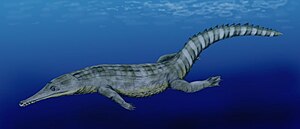Guarinisuchus
| Guarinisuchus | ||||||||||||
|---|---|---|---|---|---|---|---|---|---|---|---|---|

Guaranisuchus munizi , living reconstruction |
||||||||||||
| Temporal occurrence | ||||||||||||
| early Danium | ||||||||||||
| 62 to 61 million years | ||||||||||||
| Locations | ||||||||||||
|
||||||||||||
| Systematics | ||||||||||||
|
||||||||||||
| Scientific name | ||||||||||||
| Guarinisuchus | ||||||||||||
| Barbosa , Kellner & Viana , 2008 | ||||||||||||
| Art | ||||||||||||
|
||||||||||||
Guarinisuchus ("warrior crocodile") is a genus of extinct sea-dwelling crocodylomorpha ("crocodile relatives") from the early Paleogene of South America. The type species G. munizi established by Barbosa, Kellner and Viana in 2008 together with the genusis the only scientifically described species.
The genus assigned to the extinct Dyrosauridae is known from only one relatively well-preserved fossil find ( holotype DG-CTG-UFPE 5723) from the 62 to 61 million year old marine deposits of the Paleocene of northeastern Brazil. The characteristics obtained in the holotype in connection with the exact geochronological dating lead to a considerable expansion of knowledge about the tribal history of the Dyrosauridae, one of the few vertebrate groups that survived the mass extinction at the Cretaceous-Tertiary border .
Naming
The generic name is made up of guarini ("warrior"), a word from the Tupi language , and the Greek suchus ("crocodile"). The term "warriors (of the seas)" was chosen because these animals survived the late Cretaceous extinction event. The species addition honors Geraldo da Costa Barros Muniz for his paleontological pioneering work in the Paraiba Basin, in which the holotype was found.
Description of the holotype
The holotype consists of an almost complete skull including the lower jaw , ulna , cervical and caudal vertebrae , ribs , skin shields and individual teeth . The skull reaches a length of 52.5 centimeters and measures 16 centimeters at its widest point. The remains are not articulated (in the anatomical composite), an indication of a certain transport of the material before it is finally embedded in the sediment . Since the vertebral arch is fused with the vertebral body only in the cervical vertebrae, but not in the caudal vertebrae, it must have been a semi-adult (half-grown) individual who probably reached a length of about three meters.
Description and comparison of Guarinisuchus
With a body length of about three meters, the genus belonged to the smaller dyrosauriden Crocodylomorpha. Some apomorphies of Guarinisuchus : The pre- orbital region of the skull (area in front of the eye socket (orbit)) was narrower than in primitive Dyrosauridae, the postorbital region was relatively longer than in other dyrosaurids. The basioccipital on the occiput was elongated with a pronounced depression on the underside; Seen from below, it has a V-shaped outline that is untypical for dyrosaurids. One of the more noticeable features were the deep pits in the jaw , especially in the back of the jaw, to accommodate the opposing teeth when the animal closed its mouth ( occlusion ). The teeth of the upper and lower jaw then interlocked alternately and thus formed an effective locking system. The occlusal pits of the dyrosaurid Rhabdognathus aslerensis are similar to those of Guarinisuchus , but not as distinct. The similar ( homodontal ) dentition indicate Guarinisuchus as a fish eater . Body skeleton (if known) and teeth correspond to the conditions in other dyrosaurids.
The systematic classification of Guarinisuchus as a representative of the Dyrosauridae results from the protruding bone processes on the occiput and the horizontally (anteroposterior) elongated upper temporal window , which in this clade (family group) is always larger than the eye socket. In guarinisuchus this feature is particularly pronounced. Another synapomorphism is the snout drawn out into a long, narrow rostrum . The surface of almost all bones of Guarinisuchus is covered with holes as well as shallow pits and ridges, although not as pronounced as in most other dyrosaurids.
Location
Locality of guarinisuchus munizi
|
The holotype were by paleontologists Barbosa and Viana 2003 Poty- quarry ( 7 ° 54 '47 " S , 34 ° 51' 0" W ) discovered a limestone quarry in the area of Paulista north of Recife , the capital of the Brazilian state Pernambuco to the easternmost tip of South America. The rock of the type locality is part of the Maria Farinha Formation from the late Danium of the Paraiba Basin. The Poty quarry is of outstanding importance because it contains the most fully exposed marine deposits from the time of the turn from the Cretaceous to the Paleogene in South America and the faunal section associated with this event can be traced here. The location of the holotype is eleven meters above the Cretaceous-Tertiary border, including layers from the late Maastrichtian with mosasaurs from four different clades. This site is the only site with fossils of dyrosaurids in Brazil.
Classification of Guarinisuchus
The discovery of Guarinisuchus has contributed significantly to the understanding of the geographical distribution and evolution of the Dyrosauridae. The close relationship of Guarinisuchus to more primitive species in Africa, as well as forms in America that are younger from south to north, suggests that the dyrosaurids crossed the Atlantic Ocean and moved away from the east coast even before mass extinction at the Cretaceous-Tertiary border South America had spread through South American coastal waters to North America. The dyrosaurids in northeastern Brazil ecologically replaced the submerged species-rich mosasaur fauna from the Upper Cretaceous and, together with some species of mackerel sharks (Lamnidae), occupied the level of the top predators in the shallow Palaeocene coastal waters.
literature
The following literature was used as a basis for this article:
- José Antonio Barbosa, Alexander Wilhelm Armin Kellner, Maria Somália Sales Viana: New dyrosaurid crocodylomorph and evidences for faunal turnover at the K – P transition in Brazil. In: Proceedings of the Royal Society. Series B: Biological Sciences. Vol. 275, No. 1641, 2008, ISSN 0080-4649 , pp. 1385-1391, doi : 10.1098 / rspb.2008.0110 .
Individual evidence
Web links
- Ancient “Sea Warrior” Crocodile Unveiled Nationalgeographic.com (as of March 27, 2008)

